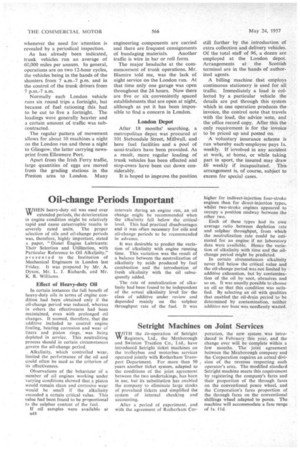Oil-change Periods Important
Page 86

If you've noticed an error in this article please click here to report it so we can fix it.
WHEN heavy-duty oil was used over extended periods, the deterioration in engine condition might be relatively rapid and cause catastrophic results in severely rated units. The proper selection of oils and oil-change periods was, therefore, highly important, stated a paper, "Diesel Engine Lubricants: Their Selection and Utilization, with Particular Reference to Oil Alkalinity," presented to the Institution of Mechanical Engineers in London last Friday. It was prepared by Mr. A. Dyson, Mr. L. 1. Richards, and Mr. K. R. Williams.
Effect of Heavy-duty Oil
In certain instances the full benefit of heavy-duty oils in terms of engine condition had been obtained only if the oil-change period was reduced, whereas in others the effectiveness had been maintained, even with prolonged oil changes. It seemed, therefore, that the additive included to control engine fouling, bearing corrosion and wear of liners and piston rings, was being depleted in service. This neutralizing process should in certain circumstances govern the oil-change period.
Alkalinity, which controlled wear, limited the performance of the oil and could often be used as the criterion of its effectiveness.
Observations of the behaviour of a number of oil engines working under varying conditions showed that a piston would remain clean and corrosive wear would be small if the alkalinity exceeded a certain critical value. This value had been found to be proportional to the sulphur content of the fuel.
If oil samples were available at n48
intervals during an engine run, . an -oil change might he recommended when the alkalinity fell below the critical, level. This had practical disadvantages and it was often necessary for oils and oil-change periods to be recommended
in advance. • It was desirable to predict the variation of alkalinity with engine running time. This variation was the result of a balance between the neutralization of alkalinity by acidsproduced by fuel combustion and the introduction of fresh alkalinity with the oil subsequently added.
The rate of neutralization of alkalinity had been found to be independent of the actual alkalinity level for the class of additive under review and depended mainly on the sulphur throughput rate of the fuel. It was higher for indirect-injection four-stroke engines than for direct-injection types, whilst two-stroke engines appeared to occupy a position midway between the other two.
• Each of these types had its own average ratio between depletion rate and sulphur throughput, from which the neutralization rate could be estimated for .an engine if no laboratory data were available. Hence the variation of alkalinity with time and the oilchange period might be predicted.
In certain circumstances alkalinity never fell below the critical value and the oil-change period was not limited by additive exhaustion, but by contamination of the oil by soot, abrasives and so on. It was usually possible to choose an oil so that this condition was satisfied., By selecting an oil with qualities that enabled the oil-drain period to be determined by contamination, neither additive nor base was needlessly wasted.








































































































































